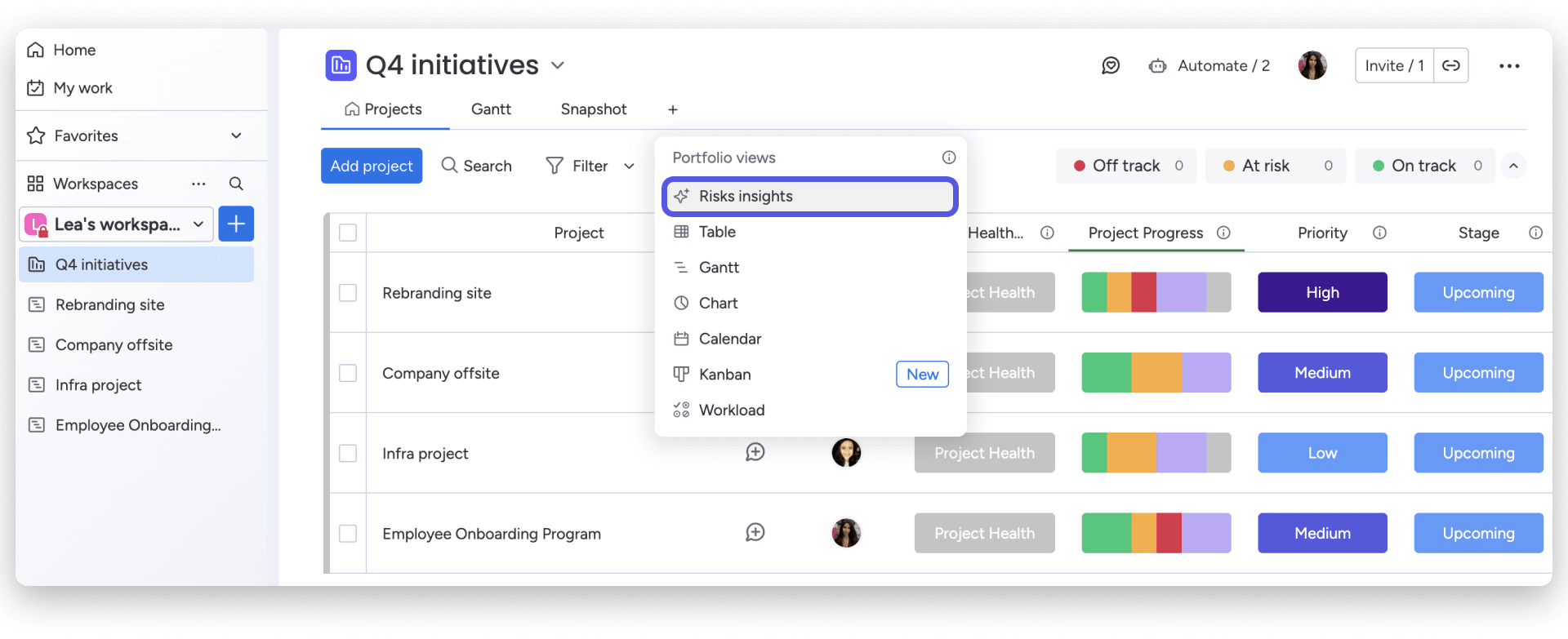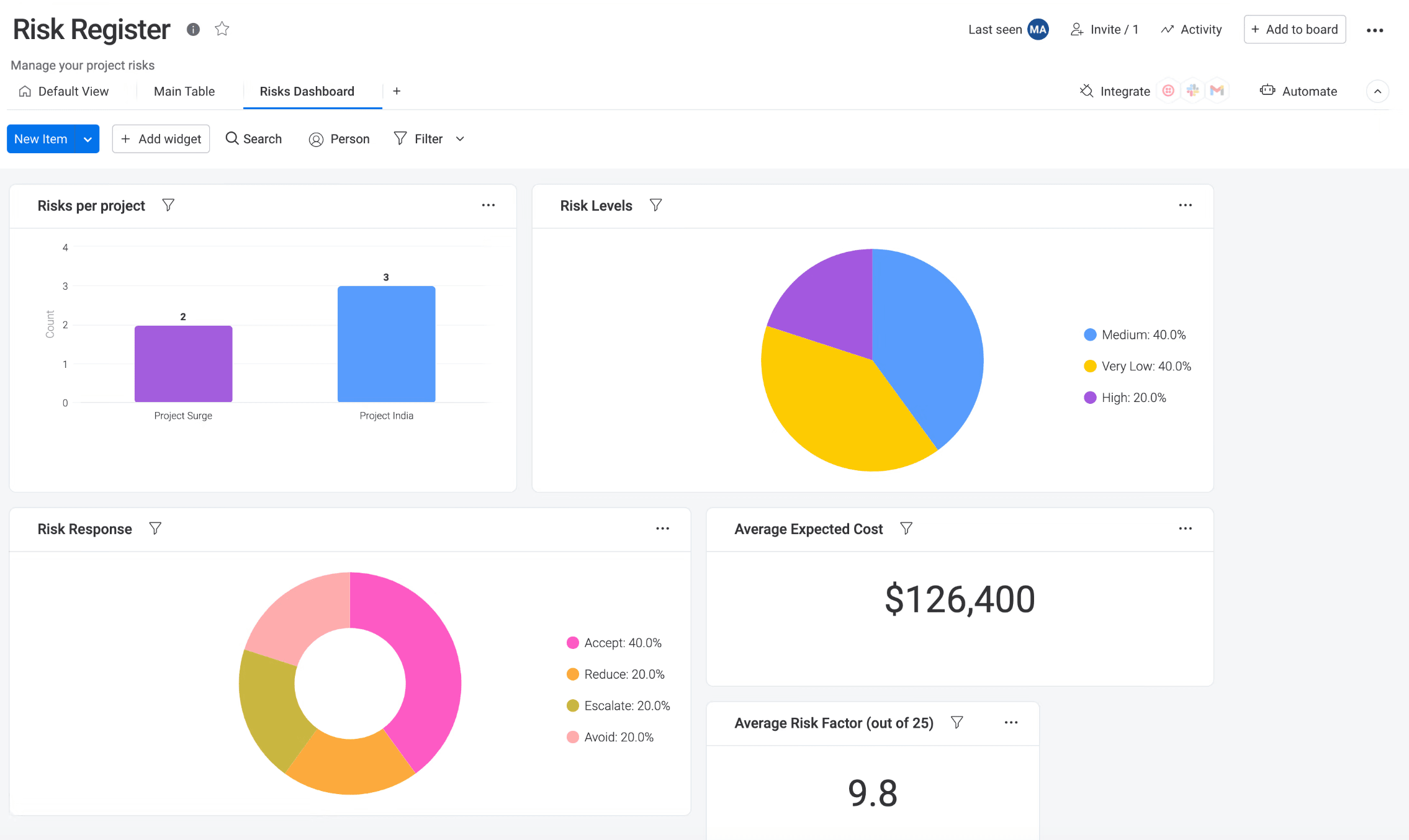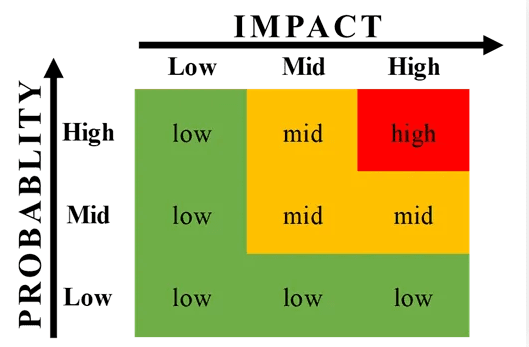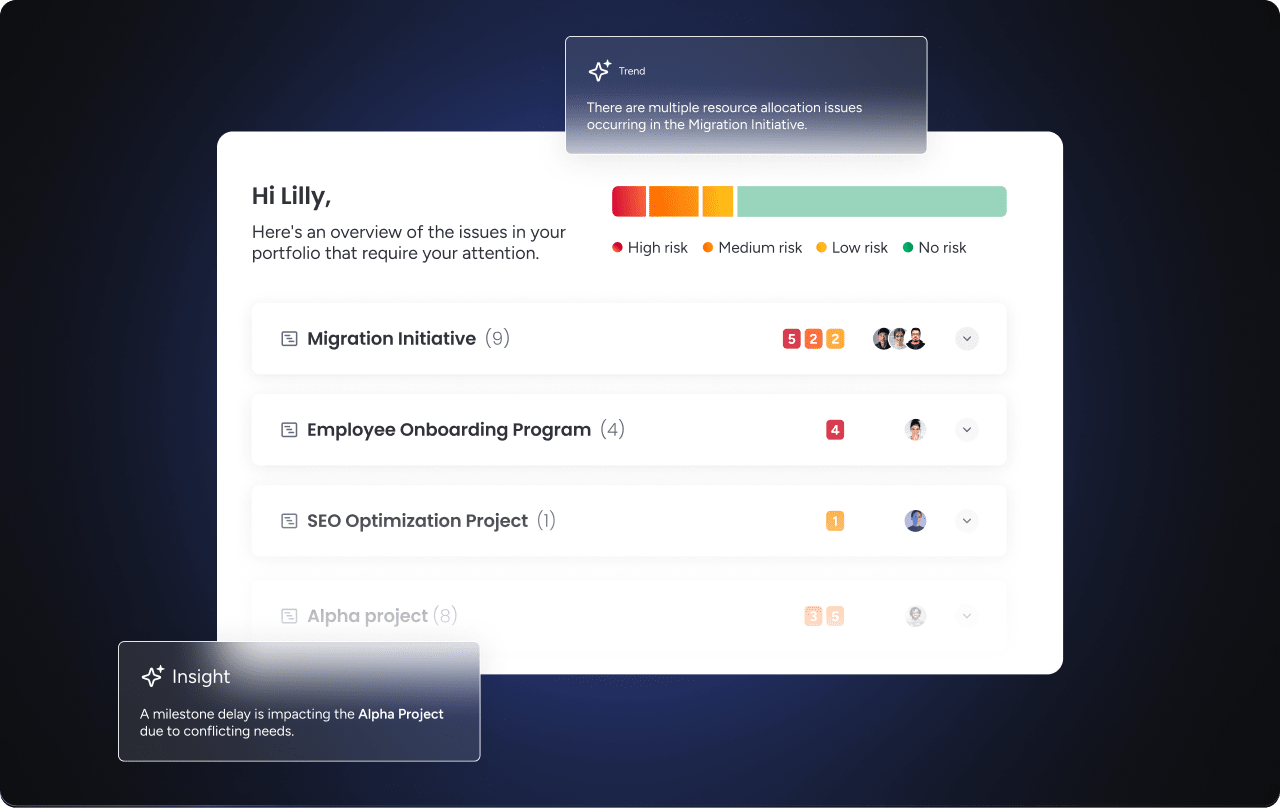Even the best-planned projects face uncertainty. Supply chain delays, staffing shortages, shifting budgets — risks appear faster than teams can react. Yet most organizations still handle them reactively, addressing issues only after they cause damage. That approach leads to lost time, missed deadlines, and unnecessary costs.
A risk register template changes that by turning risk management into a structured, proactive process. It provides a centralized system for capturing potential threats, rating their likelihood and impact, and assigning ownership before they escalate. When used effectively, it becomes less of a checklist and more of a living part of your project workflow.
This article explores how to create and automate a risk register that fits seamlessly into your day-to-day operations. Follow this guide and you will see how consistent tracking, real-time updates, and smart automation turn risk awareness into actionable control — so your team stays prepared, protected, and productive from day one.
Key takeaways
- Plan proactively: a risk register shifts teams from reacting to issues toward anticipating and managing them before they escalate.
- Write clearly: use the “If…then” format for each risk statement and assign specific owners to ensure accountability and consistent follow-through.
- Automate tracking: monday work management streamlines risk monitoring with real-time dashboards, smart notifications, and AI-powered categorization to reduce manual work and keep teams focused.
- Prioritize effectively: focus on the seven most common project risks — schedule delays, budget overruns, resource availability, technical issues, stakeholder communication, compliance, and external market changes.
- Review regularly: conduct weekly updates during active phases and monthly reviews to keep your risk register accurate, relevant, and actionable.
What is a risk register template?
A risk register template is a structured document that helps you identify, assess, and track potential risks throughout your project. With research showing that only 35% of projects are completed successfully, it’s a critical early warning system — a place where you document what could go wrong, how likely it is to happen, and what you’ll do about it.
The template provides standardized fields for capturing risk information consistently. This structure helps you account for every detail, whether you’re managing a single project or coordinating risks across an entire portfolio.
Purpose and benefits of risk registers
A risk register turns reactive problem-solving into proactive project control. By documenting potential risks in a structured way, teams can identify issues early and take steps to prevent costly setbacks.
Each risk includes a clear owner, defined mitigation actions, and a regular review cadence. This process ensures that risks discussed in meetings are tracked through to resolution rather than lost in follow-up conversations.
Modern work management solutions, such as monday work management, strengthen this structure by automating reminders, visualizing ownership, and keeping accountability visible across teams. With real-time updates and notifications, project leaders can stay informed without needing manual check-ins or constant oversight.
Risk register vs risk log explained
Understanding the difference between a risk register and a risk log helps teams manage uncertainty with clarity and consistency.
- Risk register: a comprehensive document that includes detailed assessments, mitigation plans, and ongoing monitoring. It tracks each risk through its entire lifecycle — from identification to closure.
- Risk log: a simplified list used to record risks and their current status, often updated quickly during team meetings or progress reviews.
Most teams benefit from beginning with a complete risk register template to define risk vs issue clearly, then using concise risk logs for day-to-day updates and communication.
Essential components of a risk register template
A practical risk register brings structure and consistency to every project. It turns risk management from a checklist exercise into an ongoing process that supports better decision-making. By capturing the right details in one place, teams can perform accurate risk assessment, assign clear ownership, and keep potential issues visible before they escalate.
The sections below outline the key elements that make a risk register effective and easy to maintain in day-to-day work.
Risk identification and description
Every risk needs a unique ID and a description that anyone can understand. Use the “If…then” format to create precise risk statements.
For example: “If the key supplier fails to deliver materials on time, then the project schedule will be delayed by two weeks.”
Risk categories help ensure comprehensive coverage. Common categories include:
- Technical risks: system failures, integration issues.
- Resource risks: staff availability, skill gaps.
- External risks: supplier delays, regulatory changes.
- Financial risks: budget overruns, currency fluctuations.
Risk assessment matrix
Quantifying risks enables prioritization. Most teams use probability and impact scoring on a scale of one to five or one to three.
A basic 3×3 risk matrix can further help to provide visual prioritization. Low probability, low impact risks might just need monitoring. On the other hand, high probability, high impact risks demand immediate attention and detailed mitigation plans.
This systematic approach prevents teams from wasting time on minor risks while missing critical threats.
Risk owner assignment
Clear ownership ensures action by making accountability visible and measurable. Every identified risk should have a designated risk owner who is responsible for monitoring progress and implementing mitigation steps.
The risk owner serves as the main point of contact, coordinating updates and ensuring the right people stay informed without managing every task alone.
With platforms like monday work management, automated notifications and status updates help risk owners stay on top of deadlines and maintain consistent follow-through across even the most complex projects.
Mitigation planning fields
Effective risk management requires a detailed action plan for every significant threat. To ensure a comprehensive response, your template should include fields for the following components:
- Mitigation strategy: avoid, mitigate, transfer, or accept.
- Specific actions: what exactly will be done.
- Target dates: when actions must be complete.
- Contingency plans: what to do if the risk occurs.
Document both preventive actions and contingency plans. Prevention reduces probability, while contingency minimizes impact if the risk materializes.
Monitoring status indicators
Risk status tracking shows current state and mitigation progress. Common statuses include Open, In Progress, Mitigated, and Closed.
Regular updates keep the register current and actionable. Automated tracking reduces manual maintenance while improving accuracy.

How to create and use your risk register
Building an effective risk register requires a systematic approach that we’ve outlined in the steps below. Remember, the goal is creating a living document that guides decisions and keeps teams focused on what matters most.
Step 1: set up your risk categories
Start by defining categories that reflect your project’s scope and challenges. IT teams might include cybersecurity and system integration, while construction projects focus on safety and weather. Marketing teams often consider brand reputation and market trends.
Consistent categories make risk identification more structured and complete. They also give teams a shared framework for discussion and planning.
Using monday work management, you can tailor these categories to fit your workflow while keeping structure and consistency across all projects.
Step 2: document and assess each risk
Combine multiple techniques for effective risk identification:
- Brainstorming sessions: involve diverse stakeholders.
- Historical review: learn from similar past projects.
- Stakeholder interviews: uncover individual concerns.
Write specific risk statements using “If…then” format. Vague descriptions don’t provide enough information for effective management.
Step 3: assign ownership and accountability
Select risk owners based on expertise, authority, and capacity to drive action. The ideal owner understands the risk area and has influence over mitigation activities.
Establish clear expectations including review frequency and escalation criteria. Automated reminders help maintain engagement without creating administrative burden.
Step 4: build mitigation strategies
Develop specific, measurable actions for each significant risk. Define concrete steps with clear timelines and success criteria.
Balance prevention and contingency planning. Both approaches complement each other in comprehensive risk management process.
Step 5: implement automated monitoring
Regular reviews keep your risk register current and useful. Match the review cycle to your project’s pace — weekly for fast-moving initiatives or monthly for longer programs.
Automation makes it easier to stay consistent without adding manual effort. Work management platforms such as monday work management can:
- Schedule recurring reviews and send reminders automatically.
- Generate real-time risk reports to highlight trends or emerging issues.
- Notify stakeholders when statuses, deadlines, or ownership details change.
These capabilities keep teams aligned and ensure the risk register remains a living, actionable resource throughout the project.
7 common project risks to include in your register
Understanding common risk categories helps teams build comprehensive registers. Here are the most frequent risks every project manager should monitor:
1. Schedule and timeline risks
Timeline pressures affect virtually every project. Common causes include scope creep, resource delays, and unrealistic estimates.
Risk mitigation involves building realistic schedules with buffers, defining scope boundaries, and establishing change control processes.
2. Budget and cost overruns
Financial risks can quickly impact project viability. Common causes include inaccurate estimates, scope changes, or unexpected increases in resource costs.
Mitigate these risks through careful planning and consistent oversight by:
- Building in contingency funds to absorb unforeseen expenses.
- Conducting regular budget reviews to identify trends early.
- Comparing actual costs against forecasts to stay on track.
Work management platforms such as monday work management support risk tracking by visualizing budget data in real time and helping teams respond before small overruns become major issues.
3. Resource availability risks
Key team members might become unavailable. Critical equipment might fail when needed most.
Mitigation strategies include:
- Cross-training: multiple people understand key processes.
- Backup identification: know who can step in.
- Knowledge documentation: capture critical information.
4. Technical and quality risks
Technology failures and integration challenges can derail projects, and these risks often have a high impact. For example, cybercrime alone is predicted to cost the global economy nearly $24 trillion by 2027, which affects fundamental project assumptions.
Early technical validation helps with risk identification when they’re easier to address. Include proof-of-concept development and thorough testing protocols.
5. Stakeholder and communication risks
Poor communication leads to misunderstood requirements and missed expectations. These “soft” risks are often project killers.
Regular communication, clear expectation setting, and proactive engagement throughout the project lifecycle help manage stakeholder risks effectively.
6. Compliance and regulatory risks
Non-compliance can result in fines, delays, or project cancellation. This is particularly critical in healthcare, finance, and manufacturing.
Stay informed about regulatory developments and build compliance into project planning from the start.
7. External market risks
Market conditions, competitive threats, and supplier issues represent risks beyond direct control. While you can’t eliminate them, you can manage their impact.
Be sure to monitor conditions regularly and develop flexible approaches that adapt to changing circumstances.

Risk register best practices for 2025
Modern enterprise risk management demands approaches that match today’s fast-paced environment. Here’s what separates effective risk management from administrative overhead.
Prioritize risks using impact-probability matrix
Move beyond simple high-medium-low categories. Use quantitative scoring and consider both immediate and long-term impacts.
Some risks have low immediate impact but significant cumulative effects. This broader assessment helps focus resources on risks that truly matter.
Establish clear escalation pathways
Set clear criteria for when a risk needs to move beyond the project team’s control. Escalation helps ensure timely decisions and prevents critical issues from being overlooked. Common triggers include:
- Impact thresholds: risks that exceed predefined severity or cost limits.
- Time triggers: risks that remain unresolved after a set review period.
- Resource needs: situations requiring authority or support beyond the project team.
Work management platforms such as monday work management can streamline escalation by automatically notifying the right stakeholders when predefined conditions are met, keeping responses fast and coordinated.
Schedule regular risk reviews
Establish review cadences matching project pace. High-risk projects need weekly reviews. Stable projects might need only monthly assessments.
Structure reviews for actionable decisions rather than status reporting. Focus on risks requiring immediate attention and effectiveness of current mitigation.
Integrate risk management with project workflows
Embed risk considerations into routine activities. Include a risk breakdown structure in planning, incorporate reviews into team meetings, and link mitigation actions to project schedules.
When risk management integrates seamlessly into existing workflows, it becomes part of how teams naturally work.

Track your risks automatically with monday work management
Manual tracking rarely keeps up with the pace of modern projects. As priorities shift and new challenges emerge, relying on spreadsheets or static documents can leave critical risks unnoticed. Modern risk management software enables teams to stay proactive by automating updates, centralizing information, and maintaining real-time visibility.
Within monday work management, automation and visibility work together to simplify complex processes — helping teams monitor evolving risks, coordinate responses, and maintain accountability across every project stage. The features below highlight how this approach strengthens risk tracking and supports smarter decision-making.
Real-time risk dashboards
Automated dashboards provide instant visibility across multiple projects. Visual reporting helps identify patterns that might not be apparent in text-based reports.
monday work management aggregates risk data from your entire portfolio, showing distribution, mitigation progress, and emerging threats in real-time.
Automated risk alerts and notifications
Smart notification systems ensure timely updates about status changes and escalation triggers. Critical risks trigger immediate alerts. Routine updates can be batched to avoid notification fatigue.
This eliminates manual tracking while ensuring nothing falls through the cracks.
AI-powered risk categorization
AI can automatically categorize and prioritize risks based on historical patterns, which is essential for advanced AI risk management strategies.
While 30% of employees worry AI could replace their jobs, its role here is to accelerate assessment and improve consistency, freeing up teams for high-level strategic thinking.
monday work management’s AI capabilities analyze risk descriptions and suggest mitigation strategies based on past successes.
Cross-team risk collaboration
Modern projects span multiple departments. Automated platforms enable seamless information sharing while maintaining access controls.
Collaborative features ensure all stakeholders can contribute while maintaining clear ownership and accountability.

Start managing risks effectively today
Effective risk management transforms uncertainty into competitive advantage. Organizations that systematically identify and mitigate risks deliver more consistently and build stronger stakeholder confidence.
The key is moving from reactive problem-solving to proactive management. This requires structured processes, clear accountability, and intelligent automation that scales with your needs.
monday work management provides this foundation. From automated tracking to real-time dashboards and collaborative workflows, the platform helps teams manage risks with the sophistication modern projects demand.
Frequently asked questions
How often should I update my project risk register?
Update your project risk register as often as your project pace demands. For most teams, weekly updates work best during active phases, supported by formal reviews each month or at major milestones. Projects with rapid changes or higher uncertainty benefit from more frequent check-ins, while stable initiatives may only need periodic updates to stay current.
What risk register format works best for managing multiple projects?
Standardized templates with consistent fields enable easier comparison and reporting across projects. Use the same categories, scoring scales, and status definitions while allowing project-specific customization.
Can a risk register template help meet compliance requirements?
Yes, properly maintained risk registers demonstrate due diligence in risk management. They provide documented evidence of systematic identification, assessment, and mitigation that regulators expect.
How do you measure if risk mitigation strategies are working?
Track risk closure rates, mitigation timeline adherence, and impact reduction. Compare actual outcomes to initial assessments to validate your processes and improve future risk management.
Should small projects use risk registers?
Every project benefits from risk management, but the level of detail should match project complexity. Small projects might use simplified registers focusing on the most critical risks.
What's the difference between risk appetite and risk tolerance?
Risk appetite is how much risk your organization willingly accepts to achieve objectives. Risk tolerance is the acceptable variation around specific targets. Document both to guide decisions about which risks to accept or avoid.
 Get started
Get started 

